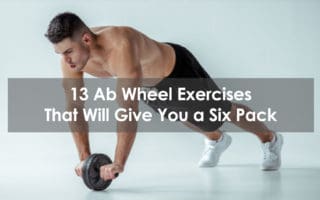Kettlebell training has been around for many years. Only recently, however, has it come into its own.
For years, those strange-looking bowling balls with handles largely collected dust as we all concentrated on the barbells and dumbbells. Over the last few years, however, more and more people are coming to appreciate the unique benefits that you get when you build your workout around kettlebell exercise.
In this article, I’m about to lay out a kettlebell full-body workout that will build muscle, torch body fat, and improve your cardio fitness all at the same time.
Why Kettlebells?
There is nothing magical about kettlebells. After all, they’re just weights with handles, so how special can they be? Well, it turns out that the kettlebell is uniquely designed to provide benefits that you do not get when you work out with barbells and dumbbells.
The difference is in the weighting and the position of the kettlebell handle. The unique shape of the kettlebell means that it is unevenly weighted. That means that when you hold it, you have to be constantly working to balance it in your hand. This contrasts with a barbell or dumbbell, which is usually weighted quite perfectly.
The instability of the kettlebell forces your body to work much harder during the exercise. And when it comes to resistance exercise, harder is better. That’s because it places more stress on the working muscles. The unstable weight also activates your stabilizer muscles far more than conventional free weights. Your core muscles and the small stabilizer muscles in your shoulder muscles will get a better workout when you train with kettlebells.
20-Minute Kettlebell Full Body Workout
This 20-minute full-body kettlebell workout is performed as a circuit. That means that there is absolutely no rest between exercises. Once you’ve completed a 7 kettlebell exercise circuit, rest for 2 minutes before repeating the circuit. Work up to completing 3 circuits.
This workout has been designed to achieve multiple training goals including:
- Building Strength
- Developing Functional Strength
- Addressing Muscle Imbalances
- Building Muscle
- Developing Explosive Power
To achieve these goals, the workout incorporates ballistic movements, athletic movements, and bilateral movement patterns. It includes power exercises like kettlebell burpees and dynamic pushups. This routine will also give you an awesome cardio workout.
You will need 2 kettlebells of equal weight to complete the circuit.
The Exercises
Kettlebell Swing
Muscles Worked
obliques, abdominals, lats, front deltoids, intercostals, improves grip strength
Step-by-Step How-To
- Stand with feet shoulder width apart and a kettlebell held in both hands at arm’s length in front of your body.
- From this starting position, hinge at the hips to drop down slightly as you swing the bell down between your legs.
- Reverse the motion to bring the weight up to shoulder level.
- Lower and repeat.
- Do 3 sets of 15 reps.
Tips
Perform your reps in a fluid, continuous, swift movement; do not round your back.
Lateral Raise
Muscles Worked
Medial (lateral) deltoids
Step-by-Step How-To
- Stand holding a kettlebell in each hand at your sides, with feet shoulder width apart.
- Keeping your arms as straight as possible, bring them up until they are at 90 degrees to your body and you are in the ’crucifix’ position.
- Lower your arms under control and return to the start position.
Training Tips
This is an isolation exercise that targets your medial delts. Do not use a weight that is too heavy or you will end up swinging and bringing the lats into the movement, which you do not want to do.
Dynamic Push Up
Muscles Worked
Pectorals, front deltoids, triceps
Step-by-Step How-To
- Adopt the press-up position grasping a kettlebell in each hand.
- Press down until your torso is just above the floor.
- Press up and, maintaining your balance, bring one kettlebell off the ground towards your chest. Ensuring you keep your balance, extend that arm above your body, bringing the kettlebell up so you are almost in a horizontal crucifix position.
- Return to the starting position and repeat.
Training Tips
Maintain a neutral spine position so that your body forms a straight line from head to toe.
Double Kettlebell Swings
Muscles Worked
Core muscles, lats, front delts, quads
Step-by-Step How-To
- In the squat position hold a kettlebell in each hand between your legs.
- Thrust upwards, swinging the weight to chest height, until both arms are fully extended.
- Under control, swing your arms back down and resume the squat position.
Training Tips
Maintain a straight back with your feet flat on the ground
Overhead Triceps Extension
Muscles Worked
Triceps
Step-by-Step How-To
- Stand with feet hip width apart, holding a kettlebell with both hands behind your neck, elbows bent.
- Extend your arms upwards, bringing the kettlebell up above your head.
- Bend at the elbows to lower the bell behind your head to full contraction.
- Return under control to the top position.
Training Tips
Do not allow your elbows to flare out; maintain a neutral spine position.
Kettlebell Burpees
Muscles Worked
Core muscles, quadriceps, shoulders, lats, chest
Step-by-Step How-To
- Adopt the press-up position grasping a kettlebell in each hand.
- Bring your knees up to your chest in one fluid motion. Then spring upwards holding both kettlebells and jump off the ground.
- As you return, squat down and place both kettlebells on the floor, then maintaining your balance, thrust your legs out.
Training Tips
The kettlebell burpee is a demanding exercise that will challenge you to the max. Start with a lighter bell than you would normally use and focus on perfecting your form before you increase the poundage.
Kettlebell Halo
Muscles Worked
Intercostals, obliques, rectus abdominus, lats, deltoids
Step-by-Step How-To
- Stand with feet shoulder width apart and a kettlebell held in your hands at chest height.
- From this starting position, lift the kettlebell overhead.
- Rotate the bell around your head in a clockwise circular motion.
- Bring it back to your chest level.
- Rotate the bell in an anti-clockwise motion.
- Perform 3 sets of 8 reps in each direction.
Tips
Maintain an upright body position, with a neutral spine to ensure proper form.
The Workout
- Kettlebell Swing – 15 reps
- Lateral Raise – 10 reps
- Dynamic Push Up – 12 reps
- Double Kettlebell Swing – 12 reps
- Overhead Triceps Extension – 12 reps
- Kettlebell Burpees – 8 reps
- Halo – 12 reps
The Bottom Line
Working out with kettlebells will introduce a whole new element of challenge to your training. At first, it will be uncomfortable and you may want to go back to dumbbells and barbells. Persevere, though, and you will be rewarded with greater gains in terms of muscle mass, core stability, balance, and fat loss. Perform the whole body workout presented here 2-3 times or week, making sure to give yourself a full day’s rest between workouts.
Frequently Asked Questions
Do kettlebell exercises really work?
That depends on what your goal is. If you are using kettlebells to lose weight, they can be an effective calorie burner, especially if you focus on such exercises as kettlebell swings and goblet squats. Kettlebell exercises allow you to perform dynamic movements which are functional and which burn a lot of calories. Grasping kettlebell handles will also improve your grip strength.
How to choose the best kettlebell weight for you?
Choosing the right kettlebell for you will be a matter of experimentation. You want to use a weight that will be challenging for the last third of the exercise but that will not be too heavy that you lose proper exercise form. As a general guide, females usually begin with a kettlebell weight between 8 and 12 kg, while most guys start with a 16 or 20 kg bell.
Can you build mass with kettlebells?
Yes, you can build mass with kettlebells. They are weights and so have the same muscle-building potential as dumbbells, with the extra benefit of instability to activate the core ad stabilizer muscles. To build muscle with kettlebells perform compound exercises with reps in the 6-12 range.







